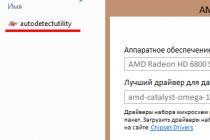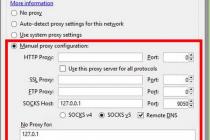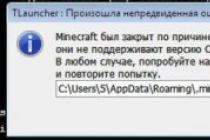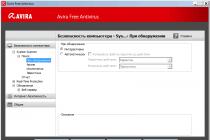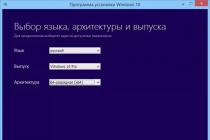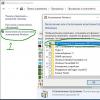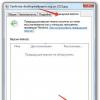7.9.Measurement of parameters in RF systems BER function measurement (C/N)
The modern BER measurement technique uses various schemes, of which two main ones can be distinguished.
Rice. 7.16. Scheme of the tunable attenuator method.
In this method, a tunable attenuator is included in the radio frequency path of the receiver, with the help of which additional attenuation is introduced, and the stability of the receive signal is assumed to be constant during the entire measurement time. The signal and noise levels are measured using a power meter, while measuring the noise in the intermediate frequency path of the receiver without filtering gives a value greater than the actual noise power in the operating band of the path. Therefore, when measuring power, additional filters tuned to the operating frequency band are used.
The BER error parameter is measured by a digital channel analyzer.
The main disadvantage of the method is the assumption of a constant power of the useful signal during the entire measurement period. In real conditions, the level of the useful signal undergoes significant fluctuations due to multipath propagation of radio waves and changes in propagation conditions. For this reason, the C/N ratio can also change, and even a 1 dB change in C/N can cause a change in BER by an order of magnitude. Thus, this method does not provide the required measurement accuracy, especially for small BER values.
2. The interference method for measuring BER(C/AT), the scheme of which is shown in fig. 7.17, uses a special device - the analyzer / simulator of the C / N parameter, which implements the measurement of the power level of the useful signal C when a given noise level N is introduced, which ensures high accuracy in determining the C / N parameter. In this method, the analyzer/simulator automatically adjusts the level of introduced noise, while the measurement accuracy of the BER(C/AT) characteristic can reach values of ~1СГ12. In conclusion of this consideration of the BER (CIN) function, we note the following.
1. Comparison of the theoretical and practical dependences VESCHS/N) show that the practical dependences differ from the theoretical ones in that a larger C/N ratio is required for practical BER values. This is due to various reasons for the deterioration of the parameter in the intermediate and radio frequency paths.
2. In practice, the contributions of the radio and intermediate frequency paths are comparable to each other, while for digital information transmission systems at speeds up to 90 Mbps, the following values of the BER degradation levels are observed.

Rice. 7.17. Scheme of the interference method for measuring BER (C / N)
IF path degradation:
Errors in the phase and amplitude of the modulator - OD dB;
Intersymbol interference associated with the operation of filters - 1.0 dB;
The presence of phase noise - 0.1 dB;
Differential encoding / decoding procedures - 0.3 dB;
Jitter (jitter) - 0.1 dB;
Demodulator noise band excess - 0.5 dB;
Other causes (aging effect, temperature instability) - 0.4 dB.
So, in total, the BER degradation in the IF path can reach 2.5 dB. BER degradation in RF path:
Non-linear effects - 1.5 dB;
Impairments associated with channel bandwidth limitation and group delay - 0.3 dB;
Interference in adjacent channels - 1.0 dB;
Impairment due to fading effects and echo - 0.2 dB. In total, in the RF path, the BER degradation will be 3 dB, that is, in total in the system
Transmission BER degradation can reach -5.5 dB.
It should be noted that in the diagrams of Fig. 7.16, 7.17 did not consider the purpose of equalizers in digital radio paths.
Frequency and power measurements in radio frequency paths.
Measurements of the frequency and power of a useful radio signal are implemented in practice by the following methods:
1) frequency meters and power meters are used,
2) Spectrum analyzers with marker measurement functions are used.
In the second method, the marker provides movement along the spectral characteristic while simultaneously displaying the values of the frequency and power parameters of the useful radio signal.
To expand the possibilities of power measurements, modern spectrum analyzers provide spectral smoothing, noise filtering, etc.
Equalizer analysis.
Compared to cable systems, radio air, as a medium for transmitting radio signals, has characteristics that randomly change over time. Due to the widespread use of digital radio communication systems and the increased requirements for the accuracy of their transmission, equalizers are turned on in receiving devices, which make it possible to drastically reduce the influence of multipath propagation (signal equalization) and group delay time (signal autotuning). When using digital methods of modulating high-frequency signals, developers have encountered difficulties in fine-tuning modems and other channel-forming devices as part of the radio frequency path. In this case, the equalizers also act as elements of compensation for possible non-linearities in the devices of the radio-frequency transmission path. In modern radio frequency information transmission systems, there are two main types of attenuation associated with the factors of radio signal propagation along the radio frequency path.
1) Linear attenuation, which is a frequency-independent uniform decrease in signal amplitude from signal distribution factors. Linear attenuation is usually due to natural factors in the propagation of electromagnetic waves:
With through distribution in forest areas;
When propagating in the atmosphere in the presence of hydrometeors (rain, snow).
2) Attenuation due to multipath propagation of radio signals.
These two factors change the amplitude of the useful signal, leading to a change in the value of the C/N ratio, which ultimately affects the BER error parameter. Changes in the structure of the useful signal associated with these two attenuations are compensated by the equalizers. As you know, the operation of any equalizer is based on the use of a narrow-band notch filter to eliminate the non-linearity of the useful signal. The main measurement parameter is the dependence of the filtration depth on the frequency at given parameter BER, which has been called the M curve or the W curve in various reviews (Fig. 7.18).

Rice. 7.18. Curves M for the cases of absence and presence of an equalizer.
To obtain the M curve, various conditions for the passage of the signal are usually simulated, which are compensated by the equalizer, and in the process of compensation, the M curve is built. The measurement scheme is shown in fig. 7.19.
As a result of the measurements, diagrams are obtained in the form of two-sided curves M, of which one is hysteresis-free (showing the ability of the equalizer filter to provide a filtering depth at a given frequency sufficient to equalize the structure of the useful signal) and the other is hysteretic (showing the filter performance when it is real work if necessary, first increase and then decrease the filtration depth parameter). In practice, both types of curves are essential for analyzing the performance of an equalizer.

Rice. 7.19. Scheme of measurements of curves M
Measurements of the parameters of the unevenness of the phase-frequency characteristic and the group delay.
The unevenness of the phase-frequency characteristic (PFC) of the radio-frequency path is determined by the group delay time (GDT) from the formula:
Direct measurement of the dependence of the phase shift on the frequency f(w) and subsequent differentiation of the obtained dependence is implemented, as a rule, for systems with a low level of phase noise, however, for radio communication systems, phase noise is present in the channel, which leads to uneven PFC and a change in the group delay. Group delay measurements are usually carried out during acceptance tests of radio systems and take into account possible deviations in the operation of the transmitter, receiver, antenna devices and radio signal propagation conditions. The paper describes two methods of group delay measurements based on the use of composite radio signals.
Measurements of parameters of resistance to linear attenuation and attenuation associated with multipath propagation of radio signals
The parameters of radio signals change due to linear attenuation and attenuation caused by multipath propagation of radio signals. When carrying out factory tests, the permissible limit of linear attenuation is introduced, not exceeding 50 dB for BER = 10~3. To compensate for linear attenuation, equalizers are used as part of the transmitter / receiver. The performance of a linear attenuation equalizer can be measured using tunable attenuators.
When measuring resistance to multipath attenuation, it is possible to use a state diagram and an eye diagram, which display:
State diagram - signal crosstalk / and Q are displayed as ellipses,
Eye diagram - the phenomenon of multipath is displayed by the shift of the centers of the "eyes" from the center to the edges.
However, both the state diagram and the eye diagram do not provide all the required measurement specification. To make practical measurements of the effectiveness of compensation for the phenomenon of multipath signaling, methods are used that are consistent with the methods of compensation. Since it is practically impossible to predict the appearance of the multipath propagation factor, the impact of this factor is taken into account by stress methods, that is, by simulating the phenomenon of multipath signal propagation. As noted in the work, two models of simulating multipath signal propagation are used.
1.Two-beam model. The principle of modeling is reduced to the theoretically justified assumption that the attenuation is due to two-beam interference, and the interfering beam has a delay (for the reflected beam) in time. From the characteristics of the unevenness of the frequency response (frequency response) and group delay for two-beam propagation of a radio signal, it follows:
Amplitude decrease with frequency change;
Change in group delay and frequency response in the case of the minimum phase (when the main radio beam has a large amplitude);
Change in the frequency response and group delay in the case of a non-minimum phase (when the resulting beam after the interference of two beams exceeds the main signal in amplitude).
2. Three-beam model. Since the two-beam model does not describe the phenomenon of amplitude modulation and the occurrence of weak beat patterns within the operating frequency range, as a result of which the amplitude of the useful signal deviates within the operating range even if the beat node is outside the operating range, a three-beam model is used to take into account amplitude shift effect. Typically, a two-beam model is used for qualitative measurements, and a three-beam model is used for accurate measurements.
Analysis of intermodulation interference.
During the propagation of radio signals in the path, intermodulation interactions of signals occur during multiplexing and demultiplexing, as well as under the influence of nonlinearities of the channel-forming devices in the path. Usually intermodulation distortion has enough low level— less than 40 dB relative to the useful signal level. Nevertheless, the control of intermodulation distortions and the elimination of their causes provides, in some cases, a solution to the problem of interference in adjacent channels. Spectrum analyzers are used to analyze intermodulation.
Measurements of the characteristics of channel-forming radio-frequency paths.
In addition to complex measurements, measurements of the characteristics of channel-forming radio-frequency paths are widely used in practice, knowledge of which is necessary in the design and operation of radio engineering systems for transmitting information. In addition to measuring the frequency and power in the service area, it becomes necessary to measure antenna systems, the level of thermal noise, the stability of the frequency of master oscillators, phase jitter, the parameters of modems and amplifying paths together with filtering devices.
Measurements of antenna systems.
Antenna-feeder devices as part of the radio frequency path play extremely important role. The main parameters: radiation power, radiation pattern in the respective planes, gain, impedance, etc., are usually calculated and measured at the stage of antenna production. During operation, important parameters are
Traveling Wave Ratio (TWR): TWF = Umin/Umax, (7.38)
Standing Wave Ratio (SWR): SWR = 1/SWR, (7.39)
The return loss level from the antenna input, where Umin and Umax are the minimum and maximum voltages in the feeder line.
In the case of ideal path matching: transmitter output - feeder - antenna input, KBV = 1 (since all the energy from the transmitter output is directed to the antenna and at the same time £ / min = Umax), in the case of Umin = 0, SWR = oo KBV = 0 - a standing wave mode occurs in the feeder, which is unacceptable.
 In a real case, SWR can take values of 1.1 ... 2, that is, KBV = 0.5 ... 0.9. In the radio paths of digital information transmission systems with digital modulation types, a low level of return loss is required, that is, a minimum SWR value of -1.1 when the mode in the feeder line is close to a high degree of matching.
In a real case, SWR can take values of 1.1 ... 2, that is, KBV = 0.5 ... 0.9. In the radio paths of digital information transmission systems with digital modulation types, a low level of return loss is required, that is, a minimum SWR value of -1.1 when the mode in the feeder line is close to a high degree of matching.
For example, for microwave links using 64 QAM modulation, the recommended level of return loss suppression from the antenna is 25 dB or higher. To measure return loss, the circuit shown in Fig. 1 is usually used. 7.20.
From the generator of microwave oscillations, a signal is fed to the antenna through a passive directional coupler. In the presence of a wave reflected from the input, electromagnetic oscillations through a directional coupler enter the spectrum analyzer (or selective receiver), where the reflected power level is measured. To reduce the level of reflected power, the matching of the antenna-feeder path is implemented. When used in practice, instead of a spectrum analyzer of a power meter, the measurement accuracy decreases, since together with the reflected signal, the power meter takes into account the level of noise associated with external influences per radio channel in a given operating frequency range.
Measurements of the level of own thermal noise of the elements of the radio frequency path.
With an increase in the noise level, the intersymbol distortion of digital signals sharply increases and the BER value increases. In state diagrams and eye diagrams, this is reflected in the increase in the size of the state display points and the “eye-closing” effect. Noise measurement various devices as part of the radio frequency path is performed during the operation phase to localize the point of increased noise level. Given that the inherent noise of various devices in the radio frequency path is small, differential methods are used for measurements. To do this, an interfering single-frequency signal is mixed into the test signal and then noise measurements are made by the difference between the interfering signal and the noise. This method is used when measuring low power noise. As an example, in fig. Figure 7.21 shows the results of noise measurements against the background of an interfering single-frequency signal for 16 QAM modulation with a signal-to-noise ratio C / I = 15 dB, while, as can be seen from the figure, an increase in the noise level leads to an increase in the size of points on the state diagram and the “eye-closing” effect » on the eye diagram.

Rice. 7.21. Examples of a state diagram and an eye diagram when measuring noise at C/1 = 15 dB.
Phase jitter measurements.
 An important measurement parameter of RF transmission systems with digital modulation is the phase jitter of the signal of the master oscillators of the receiver / transmitter, the so-called jitter (jitter). To analyze jitter, the state diagram is effectively used, since the eye diagram is not sensitive to it. If phase jitter occurs in the signal path, then, as follows from
An important measurement parameter of RF transmission systems with digital modulation is the phase jitter of the signal of the master oscillators of the receiver / transmitter, the so-called jitter (jitter). To analyze jitter, the state diagram is effectively used, since the eye diagram is not sensitive to it. If phase jitter occurs in the signal path, then, as follows from
Rice. 7.22, there is an increase in the size of the points of the state diagram. To eliminate problems associated with the presence of jitter when measuring jitter, additional measurements of the operation parameters of master oscillators are usually performed and faults are eliminated.
Measurements of modem parameters.
To measure modem parameters, analyzers are usually used, providing signal measurements in the form of state diagrams and eye diagrams, which give the most full information about the structure and changes in the parameters of digital modulation. On fig. 7.23 shows as an example a state diagram and an eye diagram for the case of quadrature amplitude modulation with 16 states of 16 QAM, from which it follows:
Blurring of points in the state diagram indicates the influence of noise;
Distortion of the size of the "eye" indicates possible violations in the operation of the digital channel (for example, the occurrence of intersymbol distortion).

Rice. 7.23. State diagram and eye diagram example for 16-state AM case 16 QAM
Consider the following types of modem malfunctions and their corresponding diagrams.
1.Loss of synchronization in digital channel.
A global demodulator failure/outage or a phase lock mismatch can result in mismatch between the modulator and demodulator, resulting in a loss of signal in the transmission system. In this case, the state diagram is a random distribution of signals over the corresponding modulation levels, the “eye” of the eye diagram is completely closed (Fig. 7.24).

Rice. 7.24. An example of loss of synchronization in a digital channel: the state diagram is a random distribution of signals over the corresponding modulation levels, the “eye” of the eye diagram is completely closed.
2. Violation of the setting of the parameters of the modulation / demodulation level.
On fig. Figure 7.25 shows a state diagram showing that when the modulation/demodulation levels were set, there was an imbalance in signal amplitude. Changes in the state diagram may indicate modulator nonlinearities or DAC malfunction.

Rice. 7.25. An example of a violation of the setting of the modulation / demodulation level parameters.
3. Violation of the orthogonality of the I and Q vectors of the demodulator.
One common modem malfunction is demodulator malfunction when the I and Q vectors of the polar coordinates of the demodulator are not strictly orthogonal. This leads to a discrepancy between the states of the orthogonal grid of coordinates on the state diagram (Fig. 7.26).
 This failure may or may not be accompanied by a phase lock error in the carrier recovery circuit. In the absence of an error, the effect of this malfunction on the eye diagram is reduced to closing the “eye” in the diagram on signal I and the absence of any change in the Q diagram. In the presence of an error, the “eyes” of both diagrams will be closed. It should be noted that the analysis of the eye diagram alone does not allow one to determine the cause of the malfunction, since this diagram completely coincides with the eye diagram in the presence of high level additive noise in the channel. A reliable determination of the cause of the malfunction in this case can only be given by the state diagram. Elimination of the described malfunction requires adjustment of the demodulator in terms of the orthogonality of the I and Q signals. In the state diagram in Fig. 7.27 noted the presence of a phase synchronization error of 2.3 degrees.
This failure may or may not be accompanied by a phase lock error in the carrier recovery circuit. In the absence of an error, the effect of this malfunction on the eye diagram is reduced to closing the “eye” in the diagram on signal I and the absence of any change in the Q diagram. In the presence of an error, the “eyes” of both diagrams will be closed. It should be noted that the analysis of the eye diagram alone does not allow one to determine the cause of the malfunction, since this diagram completely coincides with the eye diagram in the presence of high level additive noise in the channel. A reliable determination of the cause of the malfunction in this case can only be given by the state diagram. Elimination of the described malfunction requires adjustment of the demodulator in terms of the orthogonality of the I and Q signals. In the state diagram in Fig. 7.27 noted the presence of a phase synchronization error of 2.3 degrees.

Rice. 7.27. An example of the appearance of a phase synchronization error.
Measurements of the operation parameters of amplifiers as part of the radio frequency path.
The main measured parameters of the operation of amplifiers as part of the radio frequency path are:
Noise introduced by amplifiers;
Parameters of the nonlinearity of amplifying sections.
Amplitude overload can lead to the transition of the amplifier into a non-linear mode and, as a result, a sharp increase in the probability of error in a digital transmission system. The use of state diagrams and eye diagrams makes it possible to evaluate the reasons for the decrease in radio communication quality parameters (nonlinear distortions lead to the blurring of the points of the state diagram and the closing of the "eye" of the eye diagram).
The main parameter of a radio transmitting device is the power of the signal emitted into the air. It should be noted that the requirements for signal power in the VHF range are dictated by the characteristics of radio wave propagation in this frequency range.
The first feature of the VHF range is the rectilinear propagation of radio waves within the line of sight. Figure 1 illustrates this feature of radio wave propagation in this range.
Figure 1. Line of sight on the radio link
Approximately, taking into account the refraction of radio waves in the VHF range, the line-of-sight range in kilometers L is defined as:
, (1)At the height of the antenna base station and repeater 70 m, the communication range can not exceed 70 km:
When the height of the base station antenna and the repeater is 70 m, the communication range cannot exceed 70 km. Approximate line-of-sight ranges in the VHF band are shown in Figure 2.

Figure 2. Approximate range of the radio link in the VHF band
Let us calculate the output power of the transmitter signal required for a given distance. To do this, we use the well-known formula for determining the signal power at the input of the radio receiver:
It should be noted that in mobile communication systems, signal strength is measured in dBm. This attitude absolute value signal power, expressed in watts, to a signal power of 1 mW.
For example, a signal power of 2 W corresponds to a value of 33 dBm, and a signal power of 10 W corresponds to 40 dBm. This approach allows us to replace the operations of division and multiplication with subtraction and summation, respectively. In this case, the formula for determining the signal power at the input of the radio receiver (2), expressed in decibels, will take the following form:
, (4)Let us express from it the power required from the transmitter when operating in free space. For the 160 MHz band and omnidirectional antennas, this power will be equal to:
, (5)With a signal-to-noise ratio at the demodulator input of 6 dB, the transmitter power can be limited to 1 mW.
On the other hand, when a radio wave propagates along the surface of the earth, it experiences additional absorption. The Huygens-Fresnel principle is used to explain the phenomenon of radio waves wrapping around various obstacles, their penetration into the shadow and penumbra areas. In accordance with the Fresnel model, the region of propagation of radio waves between the transmitting and receiving devices is limited by an ellipsoid of revolution around the line connecting them. This ellipsoid is multi-layered and can include infinitely many zones.
The zone closest to the line connecting the transmitter to the receiver is called the first Fresnel zone. It is generally accepted that the first Fresnel zone is the most significant in the propagation of radio waves. It contains about half of the transmitted energy. Figure 3 shows a longitudinal section of the first Fresnel zone.

Figure 3. Definition of the Fresnel zone
For any point of the radio link, the radius of the first Fresnel zone (R0) can be found by the formula:
When taking into account the influence of the Earth's surface, the largest radius of the first Fresnel zone is important. With the same antenna height, this radius will be in the middle of the radio link. In this case, formula (6) is transformed to the following form:
, (7)With a radio link range of more than 5 km, it is necessary to additionally take into account the curvature of the Earth as an obstacle. This effect is illustrated in Figure 3. To take into account the rise in the level of the earth's surface in the middle of the radio link due to its curvature, you can use the following formula:
The values of the height of the obstacle created due to the curvature of the Earth, for relative distances r current /L are given in Table 1.
Table 1
| L | Relative distance on the radio interval | ||||||||
|---|---|---|---|---|---|---|---|---|---|
| 0,1 | 0,2 | 0,3 | 0,4 | 0,5 | 0,6 | 0,7 | 0,8 | 0,9 | |
| 5 km | 0.02 m | 0.08 m | 0.18 m | 0.31 m | 0.5 m | 0.31 m | 0.18 m | 0.08 m | 0.02 m |
| 10 km | 0.7 m | 1.3 m | 1.7 m | 1.9 m | 2 m | 1.9 m | 1.7 m | 1.3 m | 0.7 m |
| 15 km | 1.5 m | 2.7 m | 3.6 m | 4 m | 4.25 m | 4 m | 3.6 m | 2.7 m | 1.5 m |
Now let's calculate the additional absorption of the signal due to its shading by the Earth's surface. To do this, we calculate the height h max at the center of the radio path:
In this case, the relative clearance of the radio link will be equal to
, (10)Now, according to the graph of the dependence of the signal attenuation relative to the clearance of the obstacle, shown in Figure 4, we determine the additional signal attenuation.

Figure 4. Signal attenuation versus obstacle clearance
For a relative radio link clearance equal to -0.37, the additional attenuation of the signal will be 50 dB. As a result, the required transmitter power increases from -6 dBm to +44 dBm. This power corresponds to a transmitter power of 20 W.
In this case, we considered the situation where a single radio transmitter is located at one place. However, there are not so many places convenient for placing base station repeaters. Therefore, usually in one place a large number of radio transmitters of radio systems for various purposes is concentrated. In order for them not to interfere with each other, it is necessary to install various decoupling devices at the output of the transmitter, such as filters, circulators, combiners. Each of them weakens the power of the radio signal. In addition, the signal can be attenuated by the antenna-feeder path. The total signal attenuation value can be up to 12 dB. This leads to the fact that even if the transmitter output power is 100 W, then only 6 W will reach the antenna:
, (11)To illustrate, let's convert this value to watts:
, (12)conclusions
- To operate in the VHF band, taking into account the influence of the curvature of the earth's surface and obstacles, a transmitter power of at least 2 W is required
- For stationary radio stations, the required power increases to 50 ... 100 W due to losses in feeders and combiners
Literature:
Other parameters of radio transmitting devices:
Very important characteristic radio transmitting device is the range of radiated frequencies. For the organization of mobile radio communications in the VHF range ...
http://website/UGFSvSPS/DiapPrdFr/
When forming a radio signal, it is very important that the entire spectrum of the emitted signal be concentrated within the frequency band allocated for a given radio channel ...
http://website/UGFSvSPS/mask/
Purpose: to study the instrumental arsenal of the laboratories of the department and the main factors that determine the energy of radio links.
Satellite communication and broadcasting lines consist of two sections: a transmitting earth station (ES) - a repeater on an artificial Earth satellite (AES) and an AES repeater - a receiving ES. The signal strength at the input of the ES receiver can be determined from the formula that is used to calculate any line-of-sight radio links:
where P prd is the power at the output of the satellite repeater transmitter,
γ prd and γ prm are the transmission coefficients of the paths connecting, respectively, the output of the transmitter with the transmitting antenna on the satellite and the output of the receiving antenna with the ES receiver,
G prd and G prm are the gains of the transmitting and receiving antennas, respectively,
L o and L additional are the main and additional signal energy losses in the space between the satellite and the ES.
Major losses L o due to energy dissipation in free space when moving away from the emitter
 , (2.2)
, (2.2)
where λ is the length of the electromagnetic wave
 , (2.3)
, (2.3)
f is the frequency of the transmitter signal, c ≈ 3∙10 8 m/sec – speed of propagation of electromagnetic waves,
d is the distance between the satellite and the ES.
Distance d between AES and ES depends on altitude H satellite orbit, which determines the size of the satellite visibility zone.
A satellite visibility zone is a part of the Earth's surface from which the satellite is visible during a given duration of a communication session at an elevation angle of at least some given angle  .
.
The instantaneous visibility zone of a satellite is the visibility zone at a certain point in time, i.e. with zero session duration. When a satellite moves, the instantaneous visibility zone moves, so the visibility zone during a communication session is always less than the instantaneous one. The size of the instantaneous field of view can be estimated by the length of the arc  or corners
or corners  and
and  (fig.2.1).
(fig.2.1).

Injection  represents the angular distance of the zone boundary from the sub-satellite point
represents the angular distance of the zone boundary from the sub-satellite point  (relative to the center of the Earth), and the angle
(relative to the center of the Earth), and the angle  is equal to half of the maximum angular size of the visibility zone relative to the satellite located at the point
is equal to half of the maximum angular size of the visibility zone relative to the satellite located at the point  . points
. points  and
and  are on the border of the visibility zone and removed from the satellite at a distance
are on the border of the visibility zone and removed from the satellite at a distance 
 , called the maximum slant range.
, called the maximum slant range.
For triangle ∆  the following ratios are valid:
the following ratios are valid:
 , (2.4)
, (2.4)
 , (2.5)
, (2.5)
where R Z\u003d 6400 km is the radius of the Earth.
Additional losses L additional due to the atmosphere, precipitation and other factors.
Antenna gains when using parabolic reflector antennas with a mirror diameter D is determined from the expression:
 . (2.6)
. (2.6)
Task 2. Using formulas (2.1) - (2.6) determine the signal power at the input of the receiver of the ES located on the border of the visibility zone. The initial data for the calculation are given in Table 2.1. The variant of the task is determined by the teacher.
Table 2.1
|
f, GHz | |||||||||||
|
R prd, W | |||||||||||
|
γ prd | |||||||||||
|
γ prm | |||||||||||
|
H, thousand km | |||||||||||
|
β min, deg | |||||||||||
|
L additional | |||||||||||
|
D prd, m | |||||||||||
|
D prm, m |
Using expressions (2.4) - (2.5) determine the distance d between AES and ES.
Substitute the necessary data in the expression (2.1).
Task 3. Determine the signal strength at the input of the ES receiver located at the sub-satellite point S (fig.2.1). The initial data and the calculation procedure are the same as for task 2.
Compare the results obtained in task 2 and task 3.
Report should contain the characteristics and description of the antennas of the department, as well as the results of calculations for tasks 1-3.
WORK IN THE COMPUTER LABORATORY
SIMULATION
The purpose of the students' work is to acquire programming skills in the MatLab environment.
To enter the MatLab environment, move the mouse pointer to the logo of the software system and double-click the left mouse button (LMB).
Exercise. Building a Simulink model of the stand.
The transition to a Simulink package can be done in two ways:
after logging into the MatLab environment in command line in the control window, the simulink command is typed opposite the pointer;
with the mouse - one click of the LMB on the blue-red-black symbol containing an arrow.
After these actions, the library window (Library:Simulink) and the yet untitled (untitled) field window will open, on which the model will be assembled. In the seventh version of MatLab, to create such a field after entering Simulink, you need to click LMB on the blank sheet symbol.
First, students should become familiar with the sections of the Simulink library: Sources - sources; Sinks - loads, as well as independently find sections containing blocks Abs, F cn, Relational Operator, Mux, etc.
The blocks necessary for assembling the block diagram are dragged with the mouse from the sections of the library while holding down the left mouse button.
Models of assembled stands are shown in Fig. 3.1. Figure 3.1a shows a model containing two harmonic signal generators. The sine functions argument forms a Ramp block.



To set the parameters of this and other blocks, the block is first selected by clicking the left mouse button, and then double-clicking opens a window in which the corresponding parameters are entered. The Slope parameter of the Ramp source is set to pi /50 (in the MatLab language, the constant  written as pi).
written as pi).
By using the Mux block, the Scope becomes dual beam. The parameters of the oscilloscope models are chosen by the students themselves. Set the simulation time (Stop time) to 100: Simulation - click LMB, Parameters - click LMB, record the time in the Stop time column.
Starting the program for execution is also carried out using the mouse: Simulation - LMB click, Start - LMB click. You can also launch the program for execution by clicking LMB on the triangle icon.
It is necessary to draw (print out) block diagrams of models and observed oscillograms.
Figure 3.1b shows a model of a comparator - a device that generates a single signal when the condition specified on the block of the comparison device - Relational Operator is met.
By selecting the assembled model and using the Create Subsystem command in Edit mode, you can make the comparator model a Subsystem block. Such a block is shown in Fig. 3.1c, which shows a model of a device for comparing the signal levels of Sine Wave and Constant sources. In this simulation experiment, the amplitude of the harmonic oscillation is 1, the angular frequency is 0.1  with a simulation time of 100.
with a simulation time of 100.
Sketch (print) the model diagram and oscillograms.
Individual tasks are given in Table 3.1. The block diagram of models for all variants is the same. It is obtained from the block diagram shown in Fig. 3.1a, if the Fcn 2 block and the Mux block are excluded from the latter. Thus, the output of the Ramp block is connected to the input of the Fcn 1 block, and the input
oscilloscope Scope is connected to the output of block Fcn 1.
The simulation time for all variants is 100.
Report This section must include:
block diagrams of the studied Simulink models;
oscillograms;
Table 3.1
|
option |
Signal |
Parameter value
|
Block parameters Ramp: slope; initial output |
Exercise. 3
Theoretical part. 4
Basic provisions. 4
Units of measurement of radio signal levels. 5
Okamura-Hata model. 7
Model COST231-Khata. eight
Model COST 231-Walvis-Ikegami. eight
Research results. eleven
Exercise
1. Conduct comparative studies of empirical models of radio wave attenuation Okamura-Hata, COST 231-Hata and COST 231 Walvis-Ikegami for given characteristics of the communication channel for option 4 of the guidelines;
3. Prepare a report on the work with the presence of the following sections: 1) task, 2) theoretical part (text attached) and 3) research results - two figures with three graphs each.
Note: The calculation of the COST231Walvis-Ikegami model should be performed only for the case of line of sight.
Theoretical part
Basic provisions
Studies of radio wave propagation in urban environments have great importance in the theory and technology of communication. Indeed, the largest number of residents (potential subscribers) live in cities, and the conditions for the propagation of radio waves differ significantly from propagation in free space and semi-free space. In the latter case, propagation over a regular earth's surface is understood when the radiation pattern does not intersect with the earth's surface. In this case, with directional antennas, the attenuation of radio waves is determined by the formula:
L = 32,45 + 20(lgd km + lgf MHz) – 10lgG lane - 10lgG pr, dB =
= L0- 10lgG lane - 10lgG pr, dB. (one)
where L 0 is the main attenuation of free space, dB;
d km– distance between transmitter and receiver, km;
f MHz– operating frequency, MHz;
G lane and G pr are the gains of the transmitting and receiving antennas, respectively, dBi.
Major Debuff L0 is determined with isotropic antennas that radiate uniformly in all directions and receive the same. Therefore, attenuation occurs due to the dissipation of energy into space and a small input to receiving antenna. When using directional antennas with main beams oriented towards each other, the attenuation is reduced in accordance with equation (1).
The task of the study is to determine the radio channel that carries the message (radio signal), which provides the required quality and reliability of communication. The communication channel in urban conditions is not a deterministic quantity. Besides direct channel Interference interference exists between the transmitter and receiver due to numerous reflections from the ground, walls and roofs of structures, as well as the passage of a radio signal through buildings. Depending on the relative position of the transmitter and receiver, there may be cases where there is no direct channel, and the received signal in the receiver has to be considered the signal with the highest intensity. V mobile communications when the subscriber receiver antenna is at a height of 1 - 3 meters from the ground, these cases are dominant.
The statistical nature of the received signals requires assumptions and constraints within which decisions can be made. The main assumption is the stationarity of the random process with the independence of interference noise from each other, that is, the absence of cross-correlation. The implementation of these requirements has led to
division of urban radio channels into three main types: Gauss, Rice and Rayleigh channels.
The Gaussian channel is characterized by the presence of a dominant direct beam and low interference. The mathematical expectation of the weakening of the radio signal is described by the normal law. This channel is inherent in television signals from the TV tower when received on collective antennas in residential buildings. The Rice channel is characterized by the presence of direct rays, as well as rays reflected and transmitted through buildings, and the presence of diffraction on buildings. The mathematical expectation of radio signal attenuation is described by the Rice distribution. This channel is inherent in networks with a raised antenna above the buildings of urban sparse buildings.
The Rayleigh channel is characterized by the absence of direct beams and the radio signal reaches the mobile station due to re-reflections. The mathematical expectation of the weakening of the radio signal is described by the Rayleigh distribution. This channel is inherent in cities with high-rise buildings.
Channel types and their distribution density functions are taken into account when developing signal propagation models in urban environments. However, generalized statistics are not sufficient when calculating specific propagation conditions, under which signal attenuation depends on frequency, antenna height and building characteristics. Therefore, when implementing cellular communication and the need for frequency-area planning, experimental studies of attenuation in various cities and propagation conditions began to be carried out. The first results of studies focused on mobile cellular communications appeared in 1989 (W.C.Y. Lee). However, even earlier, in 1968 (Y. Okumura) and in 1980 (M. Hata) published the results of studies on the attenuation of radio waves in the city, focused on mobile trunking and television broadcasting.
Further studies were carried out with the support of the International Telecommunication Union (ITU) and were aimed at clarifying the conditions for the applicability of the models.
Below we consider the models that are most widely used in the design of communication networks for urban environments.
Units of measurement of radio signal levels
In practice, two types of measurement units are used to estimate the level of radio signals: 1) based on power units and 2) based on voltage units. Since the power at the output of the transmitter antenna is many orders of magnitude higher than the power at the input of the receiver antenna, multiple units of power and voltage are used.
The multiplicity of units is expressed in decibels (dB), which are relative units. Power is usually expressed in milliwatts or watts:
P dBm = 10 lg (P/1 mW),(2)
P dBW = 10 lg (P/ 1 W).(3)
For example, a power equal to 100 W, in the given units, will be equal to: 50 dBm or 20 dBW.
In units of voltage, 1 μV (microvolt) is taken as the basis:
U dBµV = 20 lg (U/ 1 µV). (4)
For example, a voltage of 10 mV is equal to 80 dBµV in given relative units.
Relative power units are used, as a rule, to express the level of the radio signal of the transmitter, relative voltage units - to express the signal level of the receiver. The relationship between the sizes of relative units can be obtained based on the equation P \u003d U 2 /R or U 2 \u003d PR, where R is the input impedance of the antenna, matched to the line leading to the antenna. Logarithmizing the above equations, and taking into account equations (2) and (4), we obtain:
1 dBm = 1 dBuV - 107 dB at R= 50 ohm; (5a)
1 dBm = 1 dBuV - 108.7 dB at R= 75ohm. (5 B)
To express the power of the transmitter, the characteristic is often used - effective radiated power - ERP. This is the transmitter power, taking into account the gain (KU = G) antennas:
EIM (dBW) = P (dBW) + G (dBi). (6)
For example, a 100W transmitter drives an antenna with a gain of 12dBi. Then EIM = 32 dBW, or 1.3 kW.
When calculating the coverage areas of a cellular base station or the coverage area of a terrestrial television transmitter, one should take into account the antenna gain, that is, use the effective radiated power of the transmitter.
Antenna gain has two units: dBi (dBi) is the gain relative to the isotropic antenna and dBd (dBd) is the gain relative to the dipole. They are related to each other by the relation:
G (dBi) = G (dBd) + 2.15 dB. (7)
It should be taken into account that the subscriber station antenna gain is usually assumed to be zero.
Okamura-Hata Model
The primary version of Okamura and his co-authors' model is designed for the following application conditions: frequency range (150 - 1500) MHz, distance between the mobile and base stations - from 1 to 100 km, base station antenna height - from 30 to 1000 m.
The model is based on the comparison of attenuation in the city with the attenuation in free space, taking into account the correction components depending on the frequency, the height of the antennas of the base and mobile stations. The components are presented in the form of graphs. Long distances and heights of base stations are more suitable for TV broadcast than for cellular communications. In addition, the resolution of the graphs is low and less convenient than the analytical description.
Hata approximated Okamura's graphs with analytical ratios, reduced the frequency range to 1500 MHz (Okamura's frequency range was overestimated and did not meet the required reliability of the attenuation estimate), reduced the distance range from one to twenty kilometers, and also reduced the base station antenna height to 200 meters and made adjustments into some components of Okamura's model. As a result of Hata's modernization, the model was named Okamura-Hata and is popular for assessing the attenuation of TV signals and in cellular communications in the range up to 1000 MHz.
For the city power attenuation L in decibels (dB) is described by the empirical formula:
L,dB=69.55 + 26.16lgf - 13.83lg +(44.9-6,55 lg d–a( ), (8)
where f is the frequency in MHz,
d- distance between the base and subscriber (mobile) station in km,
The height of the antenna suspension of the base and subscriber stations.
In formula (8), the component a() determines the influence of the subscriber station antenna height on the signal power attenuation.
For an average city and an average building height, this component is determined by the formula:
a( ) = (1.1 lgf - 0.7)– 0.8, dB. (9)
For a city with high buildings a() is determined by the formula:
a( ) = 8,3 (lg 1.54) 2 – 1.1 for f< 400 МГц; (10)
a( ) = 3,2 (lg 11.75) 2 – 5 for f> 400 MHz. (eleven)
In a suburban area, the signal propagation loss depends more on the frequency than on the height of the subscriber station antenna, and, therefore, the component Δ is added to equation (8), taking into account equation (9). L,dB, defined by the equation:
Δ L,dB = - 5,4 – (lg (0.036 f)) 2. (12)
In open areas Δ L,dB for isotropic antennas is described by the equation:
Δ L,dB = - 41 – 4,8 (lgf) 2 + 18,33lgf. (13)
The disadvantage of the Okamura-Hata model is the limitation of the frequency range to 1500 MHz and the inability to use it for distances less than one kilometer.
Within the framework of the COST 231 project of the European Union (Cooperation for Scientific and Technical Research), two models were developed that eliminated the noted shortcomings of the Okamura-Hata model. These models are discussed below.
Model COST231-Hata
1
The model allows to estimate the attenuation by the formula:
L= 46,3 + 33,9 lgf- 13,8 lgh b – a(h a) + (44,9 – 6,55lgh b) log d + C, dB, (14)
where WITH= 0 for medium cities and suburban areas and WITH= 3 for the centers of large cities.
This model is not suitable for assessing signal attenuation at distances between subscriber and base stations of less than 1 km. At short distances, the nature of the building is more pronounced. For these cases, the COST231-Walvis-Ikegami model has been developed.
Unfortunately we have there is no exact information when deliveries of specific goods are expected. It is better not to add missing goods to the package, or be prepared to wait for slow-moving goods for several months. There were cases when missing goods were excluded from sale.
It makes sense to separate the parcels. One fully equipped, the other missing items.
In order for the missing goods to be automatically reserved for you after arriving at the warehouse, you must issue and pay it in the order.
ImmersionRC RF Power Meter and 30dB Attenuator (35Mhz-5.8Ghz)
The use of transceiver equipment without preliminary adjustment and verification on the ground threatens with big troubles in the air. RF signal strength meter ImmersionRC will allow you to test and configure transceivers, as well as check the technical characteristics of the antenna. Using this device, you will be able to conduct comparative tests with different types of antennas, build radiation patterns, and measure the output power of the transmitter using the built-in attenuator (power divider).
The power meter works with both pulsed and unmodulated signal types and has a wide operating frequency range from 35MHz to 5.8GHz, allowing you to test both video and RC systems.
The device will be an indispensable assistant, from setting up homemade antennas to testing the video signal transmitter for compliance with the output power after an accident.
Don't rely on luck! Test your equipment!
Peculiarities:
Affordable price of the device, much cheaper than other similar equipment
Measurement of emitted signal levels (e.g. UHF band, audio/video transmitter signal)
Calibration on all major channels used in modeling, especially FPV
Dynamic range 50dB (-50dBm -> 0dBm without external attenuator)
Information output in MW or dBm
Includes 30dB attenuator and adapter
Specification:
Frequency range: 1MHz thru 8GHz calibrated on main channels for FPV/UAV
Power level without attenuator: 50dBm thru 0dBm
Adjustment: Programmable attenuator settings, data correction
Source of power: USB or DC 6-16V
Calibrated equipment test: > 100 in frequency/power ratio
Connector: standard high quality SMA
Attenuation of the standing wave ratio: 8GHz (typical)
Dimensions (LxWxH): L=90mm x W=52mm x H=19mm
Weight: 40g
Supply voltage: 6 - 16V DC
Current consumption: 100mA
Take the guess work out of your setups with proper testing on the ground before risking problems in the air.
The ImmersionRC RF power meter lets you test and tune both your uplink and downlink setups in power and Antenna performance. You can do comparative tests on various antenna designs or plot the radiation pattern, even test the direct output power of your transmitters using the included Attenuator.
The Power meter works with both pulsed and continuous wave signals and a wide range of frequencies from 35Mhz to 5.8GHz, allowing you to test both video and RC systems.
This is an invaluable tool for anything from hand tuning a DIY antenna to testing a video TX after a crash for proper output power. Don't just guess with your investment…Test it.
Features:
Affordable RF power measurements, a fraction of the cost of similar equipment
Measure pulsed, and continuous RF power levels (e.g. UHF, and A/V Downlinks)
Calibrated on all common bands used for modeling, and especially FPV
50dB of dynamic range(-50dBm -> 0dBm without external attenuator)
Readout in MW, or dBm
Included 30dB attenuator and adapter
Specs:
frequency range: 1MHz thru 8GHz, calibrated on common bands used for FPV/UAV
Power level without attenuator: 50dBm thru 0dBm
Adjustments: Programmable attenuator setting, readout corrected
power: USB, or DC power jack power source, 6V-16V
Calibrated against traceable test equipment at: > 100 frequency/power combinations.
connector: Standard high-quality SMA
Un-attenuated VSWR: 8GHz.
Attenuated VSWR: 8GHz (typical)
Dimensions (LxWxH): L=90mm x W=52mm x H=19mm
Weight (Grams): 40g
Supply Voltage: 6 - 16V DC
Power Consumption: 100mA

 , formed by the Fcn block
, formed by the Fcn block
